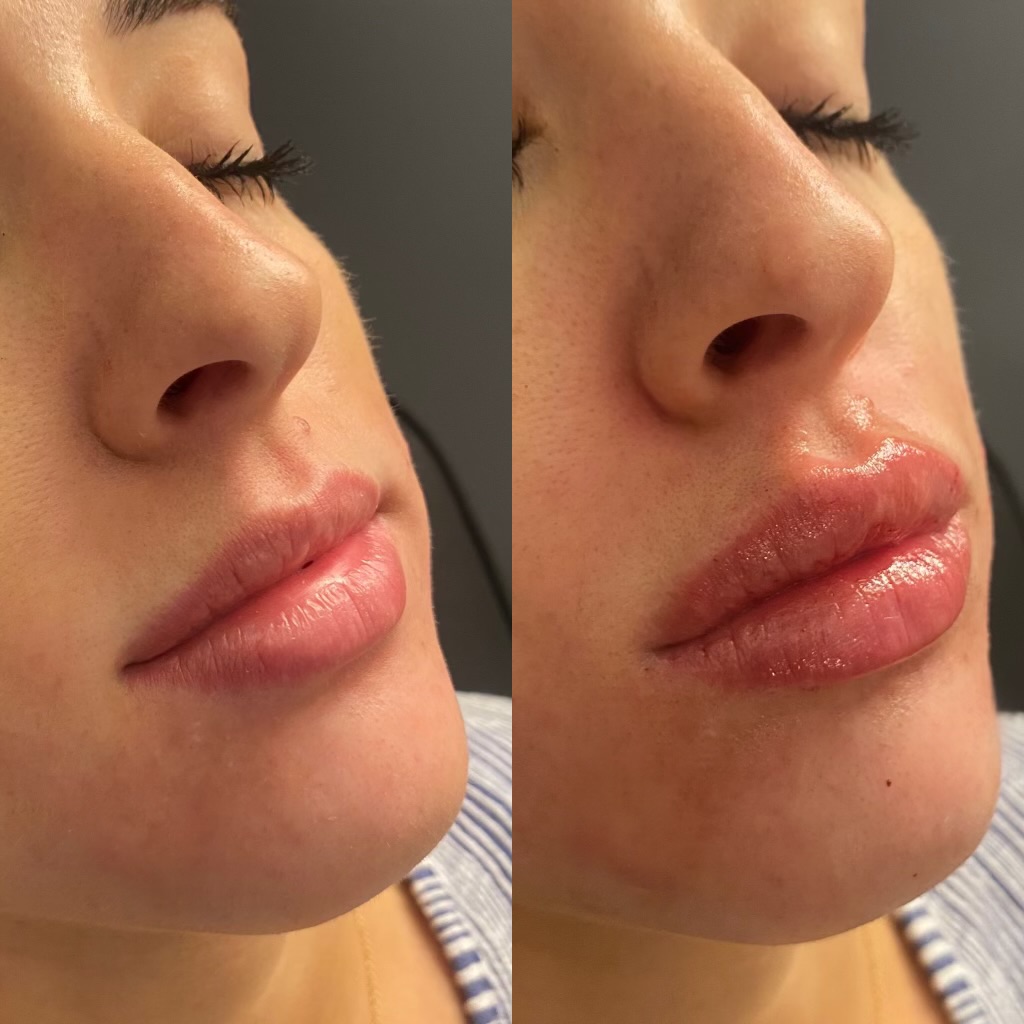
Facial injections have become a cornerstone of modern aesthetic treatments, with millions of procedures performed each year. However, despite their popularity, there’s often confusion about the differences between dermal fillers and neurotoxins like Botox. While both can help you achieve a more youthful and refreshed look, they work in different ways and are used to address different concerns.
Dermal Fillers
Dermal fillers are injectable treatments designed to restore lost volume, smooth out lines, and enhance facial contours. These fillers are gel-like substances, often made from hyaluronic acid, a naturally occurring component of the skin that retains moisture and provides structural support.
How Dermal Fillers Work
Dermal fillers are designed to add volume to specific areas of the face. They work by physically filling in wrinkles, lines, and hollows, which can create a smoother and more youthful appearance. Specifically, dermal fillers address static wrinkles—lines and hollows that are present even when your facial muscles are relaxed.
By adding volume to areas suffering from volume loss, fillers provide a smooth, youthful appearance. Common uses include:
- Plumping Lips: Enhancing lip volume and shape.
- Filling Hollow Areas: Restoring volume to cheeks and under-eyes.
- Smoothing Wrinkles: Reducing the appearance of fine lines and scars.
- Nasolabial Folds: To smooth out the lines that run from the nose to the corners of the mouth.
Because we have so many different areas on the face to treat & each area has different skin thickness and muscles movement. We cannot use the same filler all over the face. The reason there are so many types of filler is because each filler is specific to each area of the face. It is the injector’s responsibility to decide which filler is suitable for you and the treatment you are seeking.

Types of Filler Products
- Hyaluronic Acid Fillers: These are the most common and include brands like Juvederm and Restylane. They provide immediate results and last between 6 to 24 months, depending on the product and treatment area.
- Calcium Hydroxylapatite Fillers: Such as Radiesse, these provide more structural support and stimulate collagen and elastin production.
- Poly-L-Lactic Acid Fillers: Like Sculptra, these are biostimulators that encourage your body to produce its own collagen over time.
The procedure is quick, typically taking about 30 minutes, with minimal downtime. Results are often visible immediately, and a single treatment can last from several months to years, depending on the type of filler used and the area treated.
Neurotoxins
Neurotoxins like Botox are designed to target and relax the muscles responsible for dynamic wrinkles—those caused by repetitive facial expressions. These wrinkles are caused by repetitive facial movements such as frowning, squinting, pulling down on the corners of our mouth or raising eyebrows. Neurotoxins work by temporarily blocking nerve signals to these muscles, thereby reducing their ability to contract.
How Neurotoxins Work
Neurotoxins, such as Botox, Dysport, Jeuveau, Daxxify, and Xeomin, work by inhibiting the release of acetylcholine, a neurotransmitter that signals muscle contraction. This relaxation of the muscles results in a smoother appearance of the overlying skin. Neurotoxins are commonly used to treat:
- Forehead Lines: Horizontal lines that form when raising your eyebrows.
- Crow’s Feet: Wrinkles around the outer corners of the eyes.
- Frown Lines: Vertical lines between the eyebrows, also known as glabellar lines.
- Marionette Lines: the lines that form at the corners of your mouth
Differences Between Types of Neurotoxins
- Botox: The most well-known neurotoxin, Botox provides reliable results and is used for a variety of aesthetic and medical purposes.
- Dysport: Similar to Botox but may spread more easily, making it suitable for larger treatment areas.
- Jeuveau: Known for its quick onset and similar efficacy to Botox.
- Daxxify: A newer neurotoxin with a longer-lasting effect.
- Xeomin: The purest form of botulinum- A that has no proteins attached to the molecule, which may reduce the risk of developing resistance.
Neurotoxin injections usually take 15-30 minutes and you can start to see results within 3-4 days. Full effect is 21 days from treatment. The effects generally last for about 3-4 months depending on the dose you received. Beyond aesthetic benefits, neurotoxins are also used to treat medical conditions such as chronic migraines and excessive sweating.

Key Differences Between Dermal Fillers and Neurotoxins
How They Work
- Dermal Fillers: Add volume to areas of lost volume and smooth out lines that are visible at rest.
- Neurotoxins: Relax muscles to reduce dynamic wrinkles caused by facial expressions.
Target Areas
- Dermal Fillers: Can be used on both the upper and lower half of the face, the hands, neck, and décolleté
- Neurotoxins: Are used over the entire face from forehead to neck. Most frequently used in the forehead, around the eyes, & 11 lines. But treating the entire face will give you the best results
Duration of Results
- Dermal Fillers: Results can last 6-18 months, depending on the type of filler used & the rate your body metabolizes products.
- Neurotoxins: Effects generally last 3 to 4 months, with gradual muscle function returning as the neurotoxin wears off.
Treatment Goals
- Dermal Fillers: Ideal for adding volume and addressing static wrinkles.
- Neurotoxins: Best for reducing dynamic wrinkles and preventing static lines from forming.
Treatment Process
- Dermal Fillers: Injections add volume directly to the skin. Results are often visible immediately after treatment.
- Neurotoxins: Injections relax underlying muscles, with starting to see results as early as 3 days with full effect at 21 days.

Which One is Right for You?
Choosing between dermal fillers and neurotoxins depends on your specific aesthetic goals. Many patients benefit from combining both treatments to address different aspects of facial aging. For instance, dermal fillers can restore volume and smooth out deeper lines, while neurotoxins can prevent new lines from forming and maintain a youthful appearance.
Consulting with a qualified aesthetic professional can help you determine the best treatment plan based on your individual needs. At EVRI Aesthetics, our experienced team is dedicated to providing personalized treatment plans that cater to your specific needs. Whether you’re interested in dermal fillers, neurotoxins, or a combination of both, we’re here to guide you through your aesthetic journey with expertise and care.
Book a consultation with us to explore your options and embark on your journey to a refreshed, confident you.
Dermal Fillers vs. Neurotoxins: What You Need to Know
Only the best specials, education, and upcoming events—sent straight to your inbox.
EVRI Aesthetics is Delaware’s premier medspa offering a comprehensive range of aesthetic services such as Botox, Sculptra, and other medical aesthetics treatments.
(302) 666-5034
1300 Pennsylvania Ave Wilmington, DE 19806
710 Ash Blvd
Middletown, DE 19709